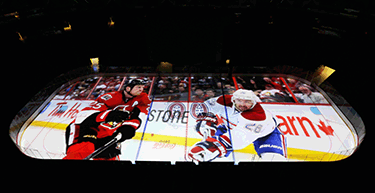Upgrades at the 21,000-seat-plus Bell Centre, home of the National Hockey League’s Montreal Canadiens, have doubled the performance capabilities of the ice rink’s pre-game show projection system, according to digital media consultancy Immersive Design Studio. The venue’s projection system, implemented by AV solutions integrator Solotech, combines Canvas_Ice, Immersive’s proprietary projector management software, NVIDIA GPU hardware, and 12 new projectors.
At the heart of Bell Centre’s new system is Immersive Design Studio’s Proprietary Canvas_Ice, a graphics processing unit capable of creating image processing up to 16K resolution with a single computer. Content may be rendered at six times HD native at 60 frames per second. At the Bell Centre, Canvas is running on two custom PCs, each outfitted with two NVIDIA Quadro K6000 GPUs. The PCs are genlocked for frame-accurate synchronization, and each drives six projectors.
The system was installed last year, reported Belgian artist and founder of Immersive Design Studios, Thomas Soetens. “But we optimized the software even further, where we now have twice as much headroom as last year. Not that we need extra headroom, but it means that the cards that we use have the capability to take on any challenge that you can throw at them—future custom effects, for example.”
The heart of the system is Canvas_Ice, a GPU (graphics processing unit) solution capable of creating image processing up to 16K resolution with a single computer. Content may be rendered at six times HD native at 60 frames per second, making Canvas future proof, said Soetens.
The technology provides a new pipeline—the term for the processing blocks that sit between the image source and the renderer—that effectively eliminates the typical tools found in such a system. If show managers have time-critical content, even the most complex interactivity, special effects, or GPU-oriented shaders can be designed directly into Canvas.
“It can become something that you do on the fly. And it’s independent from how complex your video pipeline may be before you go to the output stage.”
Consequently, time-sensitive content may be processed at the last stage rather than on the media server or at another source. “This is a revolutionary new capability,” said Soetens.
A typical complex video pipeline generates delay as processing is applied, he continued. “Before you know it, you’re losing eight frames at the projector.” In comparison, Canvas_Ice introduces just two frames of delay.
At the Bell Centre, Canvas is running on two custom PCs, each outfitted with two Nvidia Quadro K6000 GPUs. The PCs are genlocked for frame-accurate synchronization, and each drives six projectors.

Canvas is reportedly capable of calibrating the system in less than 15 minutes without any quality compromise.
Leveraging the calculation power of the GPUs, Canvas can support 100 or more—many more—projectors. “Scalability is basically infinite. I think this is one of the first solutions where it doesn’t matter how many 4K projectors you have; we can match, blend, and warp without any performance impact.”
Immersive Design Studios also developed what it is calling ice deconvolution optimization. Typically, an image projected onto ice passes through the bubbles in the ice, reflects off the white surface below, and back to the surface, creating a blurred image. Performed in real time without introducing delay, and at full resolution, the new technology produces an image 10 times sharper than the best regular projector, said Soetens. As a result, “This is the first time that the Bell Centre has broadcast any of its pre-game projection,” he reported.
Canvas will work with any projector, and also eliminates the need for a management system. “All you need to do is lens-shift your rectangle as close as possible to the borders of the ice to create the best possible light. We just ask [the operators] to overshoot the screen by 10 or 15 pixels. But there’s nothing else besides lens shift that you need to do.”
One of the Bell Centre’s challenges was a set-up time limitation, according to Soetens. The multipurpose arena frequently hosts major events such as concerts between hockey game days, and a loud rock show can vibrate the lenses out of alignment.
“You can’t be sure that your warp and blend will be as pristine as the first time that you calibrated it. So it needs to be readjusted before every ice hockey pre-game projection,” he said, and that can take hours.
“But you don’t get time because they’re still bringing down the previous show and five hours later the stadium is full for the hockey game. So they asked us if we could do it in less time. We were able to bring it down, for adjustments, to below two minutes, and for a full calibration, below 15 minutes.”
Even in a new or temporary installation, projectors need only be placed more or less symmetrically, the better to maintain a luminosity match between each, for Canvas to calibrate the system. “Imagine you have projectors randomly placed and you need to start from zero. Our system, by hand, is capable of doing this in less than 15 minutes without any quality compromise.”
Canvas introduces commercial possibilities through the clarity and resolution of its images, Soetens believes. “We think this will open the door potentially to create content for the ice surface that could even generate revenue. That is what we really aimed for. We wanted to create something that takes away the downside of the challenging surface.”Steve Harvey (sharvey.prosound@gmail.com) has been west coast editor for Pro Sound News since 2000 and also contributes to TV Technology, Pro Audio Review, and other NewBay titles. He has over 30 years of hands-on experience with a wide range of audio production technologies.
